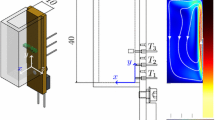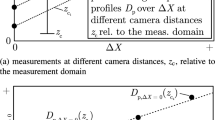Abstract
A spatially self-referencing velocimetry system based on low-coherence interferometry has been developed. The measurement technique is contactless and relies on the interference between back-reflected light from an arbitrary reference surface and seeding particles in the flow. The measurement location and the flow velocity are measured relative to the reference surface’s location and velocity, respectively. Scanning of the measurement location along the beam direction does not require mechanical movement of the sensor head. The reference surface (which can move or vibrate relative to the sensor head) can be either an external object or the surface of a body over which measurements are to be performed. The absolute spatial accuracy and the spatial resolution only depend on the coherence length of the light source (tens of microns for a superluminescent diode). The prototype is an all-fiber assembly. An optical fiber of arbitrary length connects the self-contained optical and electronics setup to the sensor head. Proof-of-principle measurements in water (Taylor–Couette flow) and in air (Blasius boundary layer) are reported in this paper.










Similar content being viewed by others
References
Büttner L, Czarske J (2001) A multimode-fiber laser-Doppler anemometer for highly spatially resolved velocity measurements using low-coherence light. Measurements Science and Technology 12:1891–1903
Büttner L, Czarske L (2003) Spatial resolving laser Doppler velocity profile sensor using slightly tilted fringe systems and phase evaluation. Measurement Science and Technology 14:2111–2120
Durst F, Zanoun ES (2002) Experimental investigation of near-wall effects on hot-wire measurements. Experiments in Fluids 33(1):210–218
Durst F, Melling A, Whitelaw JH (1987) Theorie und Praxis der Laser-Doppler-Anemometrie. Braun, Karlsruhe
Durst F, Zanoun ES, Pashtrapanska M (2001) In situ calibration of hot wires close to highly heat-conducting walls. Experiments in Fluids 31(1):103–110
Gusmeroli V, Martinelli M (1991) Distributed laser Doppler velocimeter. Optics Letters 16(17):1358–1360
Häggmark CP, Bakchinov AA, Alfredsson PH (2000) Measurements with a flow direction boundary-layer probe in a two-dimensional laminar separation bubble. Exp Fluids 28:236–242
Ligrani PM, Bradshaw PH (1987) Spatial resolution and measurement of turbulence in the viscous sublayer using subminiature hot-wire probes. Exp Fluids 5:407–417
Lin HJ, Perlin M (1998) Improved methods for thin, surface boundary layer investigations. Exp Fluids 25:431–444
Meinhart CD, Wereley ST, Gray MHB (2000) Volume illumination for two-dimensional particle image velocimetry. Measurements Science and Technology 11:809–814
Rusch D, Kempe A, Rösgen T (2007) Seeding of high temperature air flow. Exp Fluids 42:761–765
Saarimaa R (1979) A laser Doppler velocimeter for surface velocity measurement. Journal of Physics E 12:600–603
Schlichting H, Gersten K (2000) Boundary-Layer Theory. Springer Verlag, Berlin
Tomlins PH, Wank RK (2005) Theory, developments and applications of optical coherence tomography. Journal of Physics D 38(15):2519–2535
Wolff S, Brunner S, Fottner L (2000) The use of hot-wire anemometry to investigate unsteady wake-induced boundary-layer development on a high-lift lp turbine cascade. Journal of Turbomachinary 122:644–650
Author information
Authors and Affiliations
Corresponding author
Rights and permissions
About this article
Cite this article
Kempe, A., Schlamp, S. & Rösgen, T. Non-contact boundary layer profiler using low-coherence self-referencing velocimetry. Exp Fluids 43, 453–461 (2007). https://doi.org/10.1007/s00348-007-0320-4
Received:
Revised:
Accepted:
Published:
Issue Date:
DOI: https://doi.org/10.1007/s00348-007-0320-4




